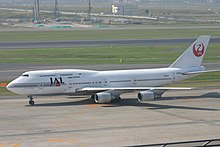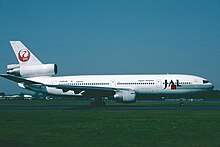| Accident | |
|---|---|
| Date | 31 January 2001 |
| Summary | Near miss |
| Site | Near Yaizu, Shizuoka, Japan 35°N 138°E / 35°N 138°E |
| Total fatalities | 0 |
| Total injuries | 100 |
| Total survivors | 677 |
| First aircraft | |
 JA8904, one of the aircraft involved in October 2006. | |
| Type | Boeing 747-446D |
| Operator | Japan Airlines |
| IATA flight No. | JL907 |
| ICAO flight No. | JAL907 |
| Call sign | JAPAN AIR 907 |
| Registration | JA8904[1] |
| Flight origin | Tokyo Int'l Airport, Tokyo, Japan |
| Destination | Naha Int'l Airport, Okinawa, Japan |
| Occupants | 427 |
| Passengers | 411 |
| Crew | 16 |
| Fatalities | 0 |
| Injuries | 100 (9 serious, 91 minor) |
| Survivors | 427 |
| Second aircraft | |
 JA8546, the other aircraft involved in April 1997. | |
| Type | McDonnell Douglas DC-10-40 |
| Operator | Japan Airlines |
| IATA flight No. | JL958 |
| ICAO flight No. | JAL958 |
| Call sign | JAPAN AIR 958 |
| Registration | JA8546[1] |
| Flight origin | Gimhae International Airport, Busan, South Korea |
| Destination | Narita International Airport, Tokyo, Japan |
| Occupants | 250 |
| Passengers | 237 |
| Crew | 13 |
| Fatalities | 0 |
| Injuries | 0 |
| Survivors | 250 |
On 31 January 2001, Japan Airlines Flight 907, a Boeing 747-400D en route from Haneda Airport, Japan, to Naha Airport, Okinawa, narrowly avoided a mid-air collision with Japan Airlines Flight 958, a McDonnell Douglas DC-10-40 en route from Gimhae International Airport, South Korea, to Narita International Airport, Japan. The event became known in Japan as the Japan Airlines near miss incident above Suruga Bay (日本航空機駿河湾上空ニアミス事故, Nihonkōkūki surugawan jōkū niamisu jiko). Had the accident occurred, it could have been the worst mid-air collision (worse than the 1996 Charkhi Dadri mid-air collision with 349 fatalities) and the worst air disaster of all time (exceeding the 583 fatalities of the Tenerife airport disaster).
The incident was attributed to errors made by air traffic controller (ATC) trainee Hideki Hachitani (蜂谷 秀樹, Hachitani Hideki) and trainee supervisor Yasuko Momii (籾井 康子, Momii Yasuko). The incident caused Japanese authorities to call upon the International Civil Aviation Organization (ICAO) to take measures to prevent similar incidents from occurring.
- ^ a b Tomita, Hiroaki (Investigator General, Aircraft and Railway Accidents Investigation Commission). "Accident Investigation into a Near Mid-Air Collision Archived December 10, 2015, at the Wayback Machine." June 12, 2005 (Queenstown, New Zealand).